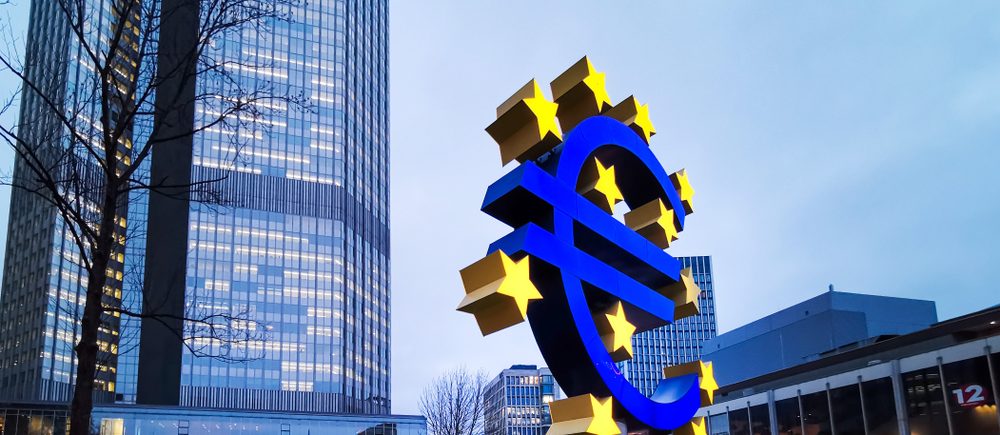The euro gained more than 1.5% against the dollar on Wednesday as risk appetite returned to financial markets and energy as well as commodity prices eased from recent peaks that were driven by Russia’s invasion of Ukraine and the Western sanctions imposed in response.
Market expectations about the potential for rate hikes from both the BoE and the ECB this year have been pared back since the Russian invasion of Ukraine.
However, while the market is still anticipating that the BoE could follow through with a third consecutive rate hike at its March meeting, the doves maintain the upper hand at the ECB.
After touching a 22-month low on Monday of $1.0806, the euro was last at $1.10645, up 1.57% on the day.
As for the ECB tomorrow, there is scope for downside if the central bank aggressively pivots to easing to relieve corporate stress, but a sharp move higher is possible if inflation risks continue to dominate Largarde’s message.
Some analysts have warned of a more hawkish possibility, the ECB will need to provide a message of a delayed, but not derailed policy path. While the ECB is likely to be less willing to make any policy changes this month in the face of the current uncertainties, policy-makers are also likely to signal that they are taking inflationary pressures seriously and that it is willing to act if necessary.
This suggests there is scope for the ECB to provide a more hawkish tone this week than many market participants are anticipating.
The move was partially driven by recent reports that the European Union was discussing a joint bond issuance to finance energy and defense spending.
Looking at the options market, the signal there has been a reduction in downside protection for the euro, so that could be signaling that the market thinks we may be moving on from the very acute phase of the shock.
A month ago, the euro was close to touching $1.15, and its rapid decline to below $1.10 may have been overdone. That is an extremely fast and steep move, and so I think we’re seeing some profit-taking and also some reversal based on that.
Against a basket of currencies including the euro, the dollar fell 1.077% to 98.052, after hitting a 22-month peak on Monday.
Markets also welcomed a pullback in commodity prices that have contributed to surging inflation and added to uncertainty around economic growth expectations.
Oil prices plunged on media reports that OPEC producers United Arab Emirates and Iraq said they would support increased production, potentially offsetting some of the supply disruptions caused by sanctions on Russian oil.
Brent crude fell more than 17% to hit a session low at $105.60 during a sharp sell-off, before recovering to $114.69 a barrel. U.S. crude was down 9.7% at $111.69.
The drop in oil prices also contributed to a rally by Wall Street’s main stock indexes, with investors snapping up stocks hammered by concerns over Western sanctions on Russia.
It is certainly a risk on move today in all the markets. European currencies such as Poland’s zloty and Hungary’s forint rose sharply, rebounding from record lows against the euro, also supported by both central banks hiking rates on Tuesday.
The European Central Bank meets on Thursday but amid the specter of stagflation, money markets expect policymakers to delay rate hikes until late in the year. IRPR
European currencies have been under heavy pressure for the past couple of weeks and some of these valuations have begun to look stretched.
Sterling rose 0.47% against the dollar to $1.3162, Poland’s zloty jumped %5.78 against the greenback to 4.3145 and Hungary’s forint rose 4.03% to 341.28.
In the United States, President Biden signed an executive order on Wednesday requiring the government to assess the risks and benefits of creating a central bank digital dollar, as well as other cryptocurrency issues, the White House said.
Analysts viewed the long-awaited executive order as a stark acknowledgement of the growing importance of cryptocurrencies, such as bitcoin and ether, and their potential consequences for the United States and global financial systems.
The EUR/GBP pair was rallying on Wednesday to 0.8417 from a low of 0.8314 on the diverging policy expectations from the Bank of England and the European Central Bank that meets on Thursday. This will be a key and popular meeting among central bank watchers as the Governing Council has the unenviable task of being the first team from the major central banks to provide an assessment of the impact on the Ukrainian crisis on growth, inflation and monetary policy.
Worries about Germany’s energy security increase the vulnerability of the EUR vs. the GBP. This will likely slow any recovery in EUR/GBP and opens downside potential in the near-term.
On the downside, the first level to watch is the bottom of the bear channel at around 0.827. We would expect considerable support in the 0.8250-0.8200 area given that a break below would leave GBP eyeing up pre-2016 Brexit referendum levels.
Meanwhile, although the EZ has more direct Russian trade exposure, the UK has greater financial market links through banks and assets. The war has also led experts to warn Brits will absorb one of the harshest blows to their finances in peacetime.
The CEBR estimates living standards in the UK will drop at the worst rate since records began in the mid-1950s. Elevated inflation and weaker growth will cause a headache for both the BoE next week and Chancellor Rishi Sunak, who is preparing to deliver a spring statement on 23 March.
 Noor Trends News, Technical Analysis, Educational Tools and Recommendations
Noor Trends News, Technical Analysis, Educational Tools and Recommendations





